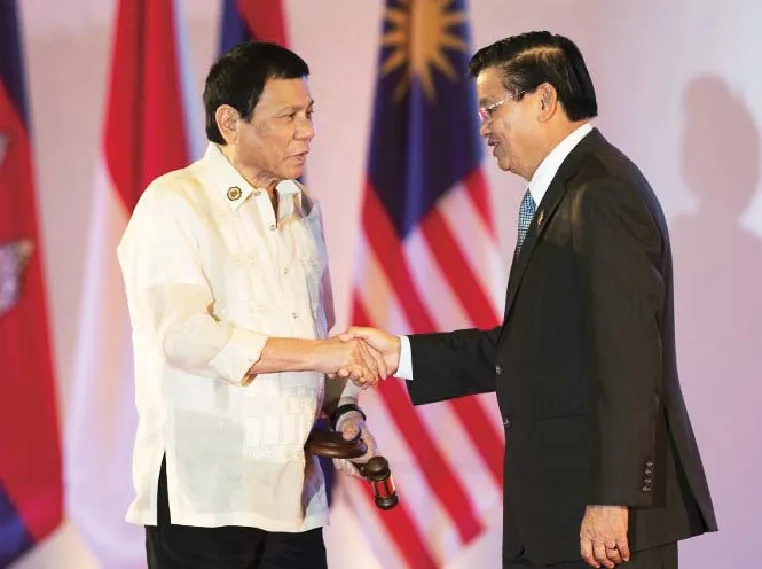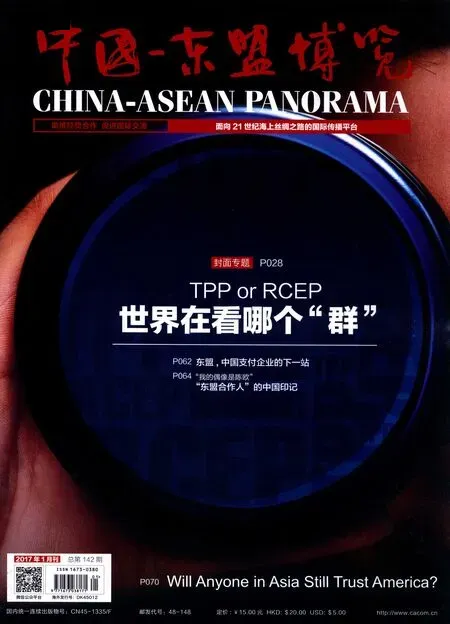推動東盟經濟一體化輪值主席國菲律賓有哪些動作
□ 文/亨利·J·舒馬赫
By J. Berkshire Miller
推動東盟經濟一體化輪值主席國菲律賓有哪些動作
□ 文/亨利·J·舒馬赫

2016年9月8日,東盟峰會閉幕儀式在老撾萬象舉行,菲律賓接棒老撾成為2017年東盟輪值主席國
東盟經濟共同體將著力促進東盟域內貨物和人員往來便利化。東盟十國蘊含著前所未有的商業機遇,經濟高速發展,市場潛力巨大,擁有近6.3億的消費人群。隨著東盟域內投資貿易規模的不斷擴大,該區域的經濟發展前景可觀:經濟發展速度加快、就業率提高、區域價值鏈形成等等。值得注意的是,目前東盟各成員國之間的交易額僅占地區貿易總額的24%;因此,擴大東盟域內貿易規模,建立服務于東盟市場的經濟樞紐,任重而道遠。歐盟—東盟貿易投資關系已得到全面確立。東盟是歐盟在歐洲地區以外的第三大貿易伙伴,而歐盟則是東盟的第二大貿易伙伴,僅次于中國。鑒于此,深化東盟區域融合,加強東盟各成員國之間的邊境貿易與投資以及加強東盟與歐盟之間的投資貿易合作,意義重大,將使歐洲地區及菲律賓國內的歐盟企業受益良多。值得一提的是,菲律賓將在2017年擔任東盟輪值主席國。菲律賓將利用這一絕佳的機會,帶領東盟各成員國繼續深化東盟經濟一體化。
貿易便利化
盡管東盟地區的絕大多數產品享受零關稅待遇,或按0~5%的稅率繳納關稅,但非關稅貿易壁壘仍在很大程度上限制著東盟域內的許多產品交易。因此,通過加強東盟各成員國之間的融合來消除非關稅貿易壁壘(尤其是原產地規則、產品標準及檢驗等),勢在必行。在此背景之下,東盟各成員國應統一海關監管流程,并就醫療保健、食品飲料、汽車等重要行業簽署標準互認協議。化妝品行業就是體現區域標準化的一個典型案例。菲律賓化妝品行業采用并實施了《東盟食品藥物監管指令》中所涵蓋的《東盟統一化妝品監管計劃協定》等相關規定。
聚焦汽車行業
目前,由于缺少統一的產品標準,菲律賓及東盟地區的汽車行業(包括汽車整車及零配件)的貿易受到諸多非關稅貿易壁壘的限制。因此,菲律賓應充分利用2017年擔任東盟輪值主席國的機會,實現東盟汽車行業的產品標準向聯合國歐洲經濟委員會審批流程的相關標準看齊。現在,雖然東盟汽車行業的部分產品標準已達到聯合國歐洲經濟委員會關于汽車整車的管理規定,但仍有一部分車輛零備件未達到相關要求。菲律賓應以身示范,促使東盟各成員國就汽車行業標準簽署互認協議,推進與聯合國歐洲經濟委員會相關標準相一致的標準化建設。值得注意的是,部分東盟成員國對聯合國歐盟經濟委員會在汽車零配件方面的標準管理辦法表示認可。
東盟“一站式”服務窗口
加快設立綜合性強的東盟“一站式”服務窗口,有利于促進東盟邊境貿易和域內貿易的發展,最終推動區域經濟增長和地區融合。對菲律賓來說,首先要建立一個既具綜合性又充滿活力的國家級“一站式”在線服務窗口,從而更好地參與東盟“一站式”服務窗口的籌建。
簡化海關通關手續,推動域內貿易發展
目前,東盟各成員國仍對彼此之間的海關通關設置了多道關卡,阻礙了東盟域內貿易的發展。菲律賓應與東盟其他成員共同協商,精簡優化海關通關作業流程,如采用東盟海關對接系統、實現報關通關電子數據交換等等。近日,根據世界貿易組織《貿易便利化協定》和世界海關組織《京都公約》(修訂版)的相關規定,菲律賓頒布了《現代化海關和關稅法案》的實施細則,最大程度地簡化通關手續。東盟其他國家也可采用該法案,從而推動域內貿易便利化。
保護知識產權,嚴禁非法貿易
東盟統一市場的形成,擴大了非法貿易和假冒偽劣產品的發展空間。因此,要確保東盟經濟體促進域內貿易和投資的發展目標順利達成,就必須在東盟各成員國之間實現合作機制化。
實施統一的區域標準與法規
除了加強貿易便利化以外,應在東盟區域內確立統一的標準與法規,建立互認機制,以確保投資便利化。制定適用于東盟各成員國的統一標準,對區域價值鏈的發展和拓展具有決定性作用。《東盟統一化妝品監管計劃協定》將會是探索建立統一區域標準與法規的一次有益嘗試。
放寬長期性投資約束限制
東盟各成員國需共同制定積極措施,解決投資商在東盟區域內進行長期投資時所關切的問題。菲律賓及其他東盟國家可在新加坡、馬來西亞和泰國所達成的協議基礎上,舉辦更多跨境資金募集活動,拓展跨境產品銷售渠道,吸引更多跨境投資,同時為中間商進駐東盟市場提供更多便利。
·許志亮 編譯
·來源:菲律賓《商業鏡報》
Will Anyone in Asia Still Trust America?
By J. Berkshire Miller
At the conclusion of the leaders’summit of the Asia-Pacific Economic Cooperation (APEC) in Peru last week, the Pacif c Rim trade group reasserted the importance of free trade in a joint communiqué. The APEC economies, including the United States, further committed to “keep our markets open and to fight against all forms of protectionism” — an intentional pushback to the growth of protectionist rhetoric, especially from the incoming administration in Washington, D.C.
循證護理學綜合了臨床最佳的護理經驗,針對護理工作中出現的問題,制定可行的護理措施,可避免工作的盲目性,最大程度為患者提供最佳的服務,滿足患者疾病康復的需要。隨著醫學技術不斷的進步與完善,患者的治療需求也越來越高[6-7],循證護理的實施依據是實事求是,同時也是護理人員保護自身合法權益的有力措施。研究中觀察組采用循證護理,護士打破了傳統的護理方法,通過查閱文獻不斷改進護理工作,保證護理工作具有更加科學的證據。綜上所述,采用循證護理可有效的降低護理工作者及患者家屬護理的工作量,值得臨床推廣。
President-elect Donald Trump has vowed, most recently in a YouTube video released on November 21, to make America’s withdrawal from the Trans-Pacific Partnership (TPP), the US-led flagship free trade deal in the Asia-Pacific, a top priority for his administration. Trump’s vitriol has already eliminated any chance that Congress will ratify the pact during the remaining lame-duck period of the current administration.
America’s credibility in the region is already crumbling before the TPP’s off cial burial. The almost certain failure of the deal — at least in its current form— is a body blow to key US allies, especially Japan, and other important states in Southeast Asia, such as Vietnam and Singapore, that viewed the deal as the litmus test of Washington’s commitment to Asia. Singaporean Prime Minister Lee Hsien Loong put it best on the potential of the TPP failing: “It is your credibility as an ally (that is at stake). How can anyone believe in you any more?”
Indeed, the election of Trump has
rattled US friends and allies in the Asia-Pacific who are worried that the incoming administration might signal Washington’s gradual retreat from the region. The range of concerns among US allies, such as Japan and South Korea, is vast: from the questioning of alliance burden-sharing, to the new administration’s plans for North Korea, or the black box that is Trump’s strategy— or lack thereof — for dealing with China.
But the most critical of these issues is the likely death of the TPP, which sounds the knell for Washington’s wider strategic plans. Specifically, it marks a fatal blow to US President Barack Obama’s “rebalance” to the Asia-Pacific. This was a policy grounded on three legs — economic, diplomatic, and security — but the economic foundation, and arguably the most critical strategic element, was the TPP, a 12-country deal that encompasses nearly 40 percent of the world’s gross domestic product. The TPP was meant to bridge the gap and connect Washington’s Asia policy into a long-term strategy, binding the region not only to the United States, but also enhancing regional economic interdependence and cooperation.

The Merlion in Singapore
Rather than relying on the traditional“hub and spoke” model of US engagement in Asia that focuses on bilateral relationships and alliances, the TPP is meant to support a more integrated and overlapping diplomatic and economic network — led by theUnited States — that connects like-minded countries in the region. The prospect of this network was especially enticing for most states in the region. Although they have deep interest in nurturing economic ties with China, they are desperately looking for a hedge to the emerging Sinocentric economic order in the region.
This dissipation of US credibility will be most acute in Southeast Asia, where the TPP originated. The failure of the United States to follow through on its commitments to economically engage with the region will result in weakened relationships. While the United States theoretically has two treaty allies in the region, the Philippines and Thailand (non-TPP members), these relationships are fragile and have become the Achilles’heel of Washington’s security network in Asia due to the emergence of strongman politics in both states —a military junta in Thailand and an erratic nationalist president in the Philippines.
The TPP was important because it targeted less established relationships in Southeast Asia with key emerging states such as Vietnam and Malaysia. Trade was the effective unif er for many states here who craved stronger ties with Washington but did not want to fully join in on containing China. The capital developed through the promise of the TPP helped nurture Washington’s relations with the region – as evidenced by the unprecedented growth in the defense relationship with Vietnam.
None of this is now likely to happen. While Trump’s eventual landing spot on regional security issues remains uncertain, his economic views are clear. He has labelled the reform of international trade policy, including not just the TPP but also the North American Free Trade Agreement, a top priority for his administration.
Most of Trump’s critique on the TPP focuses on its alleged bolstering of Asian economies at the expense of American jobs. This protectionist argument holds little water, considering that higher-paying jobs in US companies are largely supported by Washington’s ability to sell exports overseas. The TPP, in addition to other free trade agreements the United States has in force, would allow the US lower tariffs and barriers to free trade in the dynamic Asia-Pacific region. According to an analysis by the Peterson Institute for International Economics, the TPP would provide an estimated US$ 131 million increase in real income in the United States by 2030. This would also be complemented by an estimated US$ 357 billion growth in exports by 2030 as a result of a completed pact. In addition to the economic dividends, the TPP differs from other large trade agreements as a result of its commitment to setting a standard for high-level free trade, which took years of grueling negotiations to establish. Essentially, the TPP is intended not just to lower tariff rates and provide market access, but to go the extra mile by insisting on intensive structural and regulatory reforms among the signatories. Many of these commitments for reforms come at a high political cost for US allies, like Japan, and emerging friends in the region, like Vietnam, who are now stuck with a decision on whether to scrap the deal they invested so much time and capital in, or accept a “TPP-lite” without the United States for the foreseeable future.
The step backward on the TPP has re-energised agreements largely led by China, including the Regional Comprehensive Economic Partnership (RCEP). While the memberships of the TPP and the RCEP include a large overlap, the most striking difference is the absence of China in the former, and the United States in the latter. Beijing is also likely to push harder on its economic plans for the region by promoting its Asian Infrastructure Investment Bank and the Belt and Road initiative. Beijing may also look to pry away US influence in the region through work to finalise its trilateral trade negotiations with Japan and South Korea. China already inked a bilateral deal with South Korea in 2015. Other possible avenues would be the Free Trade Agreement in the Asia-Pacif c.
The failure of US commitment on the TPP erodes the legacy of Obama’s signature foreign-policy initiative, the rebalance to Asia. It also leads to uncertainty in the region on where to look for leadership. Japanese Prime Minister Shinzo Abe, who was originally opposed to the TPP, has ironically become the deal’s most prolific salesman.“Success or failure will sway the direction of the global free-trade system and the strategic environment in the Asia-Pacific,” he said. The warning is not just a ploy to stoke fear in Washington, but represents the concerns of many of Washington’s most trusted friends in the region. Trump should consider the consequences.
·Source: The Washington Post

